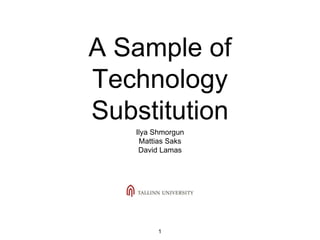A Sample of Technology Substitution
- 1. A Sample of Technology Substitution Ilya Shmorgun Mattias Saks David Lamas 1
- 3. Technology Substitution ŌĆó Our activities are being supported by a wide range of digital artifacts. ŌĆó These artifacts can be dynamically substituted based on the context of the activity. 3
- 4. Goal of Research Gain an understanding, which artifacts are being used and continuously substituted and under which circumstances. 4
- 5. Research Questions ŌĆó Which types of devices people use? ŌĆó In which circumstances people use their devices? ŌĆó Which types of services people use on their devices? ŌĆó Which specific features of those services are used on which devices? 5
- 6. Survey 6
- 7. Method ŌĆó Semi-structured questionnaire. ŌĆó Quantitative data about usersŌĆÖ activities. ŌĆó Qualitative data through open-ended questions. 7
- 8. Pilot Study ŌĆó Accidental sampling with 4 respondents for online and 3 for face-to-face testing. ŌĆó Insights into completion times and potential areas of misunderstanding. ŌĆó Improvements to the list of service types. 8
- 9. Deployed Study ŌĆó Self-selection sampling. ŌĆó People were invited through Facebook and university mailing lists. 9
- 10. Structure ŌĆó Section 1: Personal information ŌĆó Section 2: Services and devices ŌĆó Section 3: Additional questions 10
- 11. Results ŌĆó 101 full responses. ŌĆó 58,4% - male; 41,6% - female. ŌĆó 53,5% - under 26 years old; 46,5% - 26 and older. ŌĆó 9 countries represented, with most respondents from Estonia and Cape Verde. 11
- 12. Usage of Devices 0 25 50 75 100 Laptop Smartphone Desktop Tablet Smart TV 12
- 13. Device Ranking Rank 1st Rank 2nd Rank 3rd Rank 4th Rank 5th Smartphon e 22.8% 36.6% 21.8% 5% 4% Tablet 3% 9.9% 21.8% 15.8% 5% Laptop 53.5% 30.7% 12.9% 1% 0% Desktop 20.8% 17.8% 21.8% 11.9% 3% Smart TV 0% 3% 2% 11.9% 22.8% 13
- 14. Regularly Used Services 0% 25% 50% 75% 100% Communication Social networking Office applications File sharing Calendars Reading Blogging Note-taking Task management 14
- 15. Service Usage on Devices Smartphone Tablet Laptop Desktop Communication 96.1% 96.9% 94.5% 94.4% Social networking 90.9% 84.4% 87.9% 90.7% Office applications 84.4% 90.6% 85.7% 85.2% File sharing 71.4% 68.8% 65.9% 70.4% Calendars 62.3% 68.8% 54.9% 61.1% Reading 51.9% 62.5% 47.3% 48.1% Blogging 48.1% 46.9% 42.9% 40.7% Note-taking 48.1% 43.8% 42.9% 44.4% Task management 40.3% 46.9% 37.4% 37% 15
- 16. Additional Analysis Based on the collected demographics we compared: ŌĆó Men and women ŌĆó Estonians and Cape Verdeans ŌĆó People under and above 26 The significance threshold was 10%. 16
- 17. Device Usage by Gender ŌĆó Men use more desktops, tablets, and Smart TV-s. ŌĆó Women use more laptops and smartphones. 17
- 18. Device Usage by Country ŌĆó Estonians use more devices in general than Cape Verdeans. ŌĆó The most significant difference is in the usage of smartphones and Smart TV-s. 18
- 19. Device Usage by Age ŌĆó Older people use more devices. ŌĆó There was an almost 2x difference in usage of desktops and tablets. 19
- 20. Device Ranking 20 1st place 2nd place 3rd place 4th place 5th place Laptop Smartphone Desktop Tablet Desktop Smartphone Desktop Tablet Smart TV All Men Cape Verdeans Men Women Cape Verdeans Men Cape Verdeans All Women Estonians Under 26 Estonians Estonians Over 26 Over 26 Under 26 Over 26
- 21. Service Usage ŌĆó Social network usage is skewed more towards women. ŌĆó Men prefer to use calendaring, reading, note-taking, and task management services. ŌĆó Estonians use more calendaring, file sharing, blogging, and task management. ŌĆó Usage of file sharing, calendaring, and blogging is skewed towards those above 26. 21
- 22. Service Usage on Devices 22 Men Women Estonians Cape Verdeans Under 26 Over 26 Blogging and task managements done most on tablets, the least on desktops. Use laptops the least across all services. Use laptops the least for reading and calendaring. Do not use smartphones for calendaring at all. Service usage is unevenly distributed, especially in case of file sharing, calendaring, reading, and blogging. Tablets are preferred for reading and blogging. In case of file sharing there is a preference towards desktop usage, whereas reading is done more on tablets, less on laptops. For file sharing, calendaring, reading, blogging, note-taking, and task management, service usage is very unevenly distributed. Smartphones are quite commonly used as well, while laptops are used less. Task management is preferred on mobile devices instead of the desktop.
- 23. Discussion ŌĆó People want to be up-to-date anytime, anywhere, and on any device. ŌĆó Cross-device services and the possibility to synchronize data put users on top of things. ŌĆó Yet survey results also show that there are differences in all of the analyzed segments across both device and service usage. 23
- 24. Conclusion ŌĆó Take a close look at unique features of each target group when designing solutions for technology substitution. ŌĆó Understand whether people want to have access to services across all of their devices, but are currently not able to, or whether they prefer to use specific devices for specific purposes. ŌĆó Address the implications of designing for ever-changing software and hardware configurations. 24
Editor's Notes
- #9: The sample was drawn from the part of the population close to hand. The resulting sample was not representative but sufficient for the purposes of the pilot study.
- #10: The sample is based on the judgement of the researcher. Participants are invited to answer an online questionnaire and the sampling minimizes the time needed to contact respondents as well as increases the chances that they will answer the survey. The selection however may be biased and so our generalizations are made only on the level of the sample.
- #17: 10% was selected because most resulted differed by either less or significantly more than 10%.
























